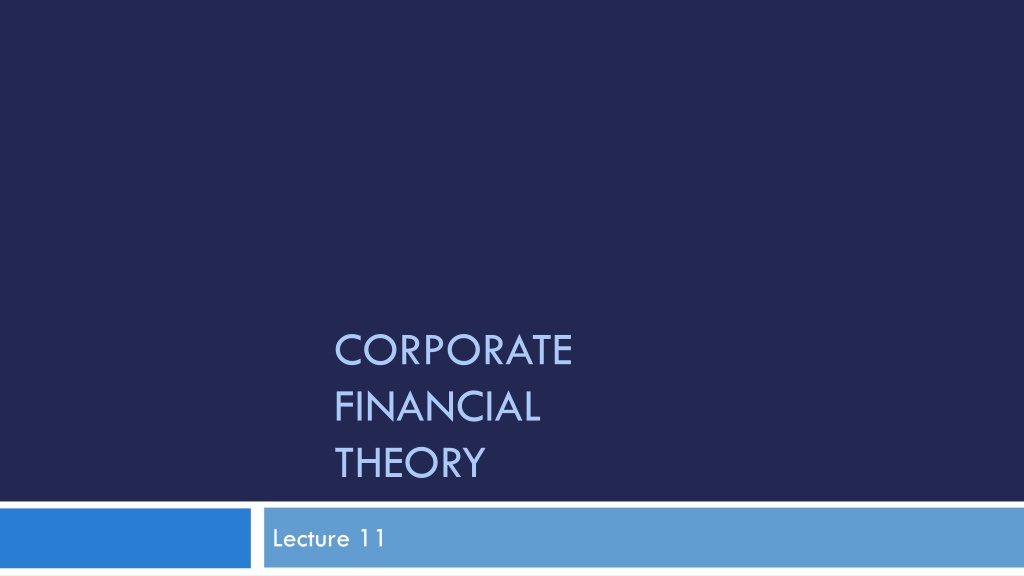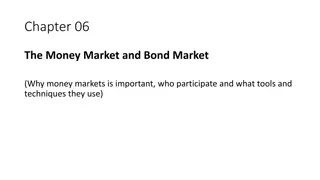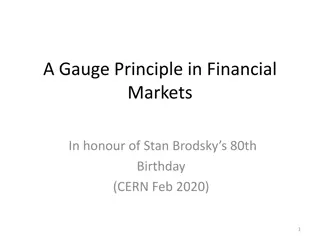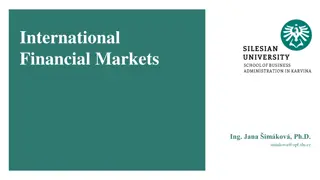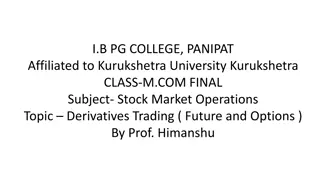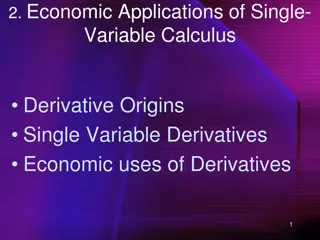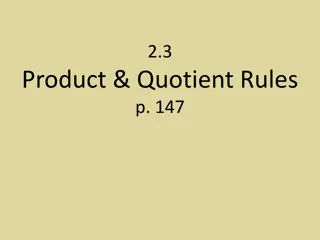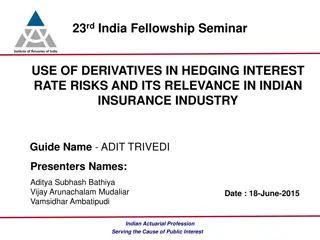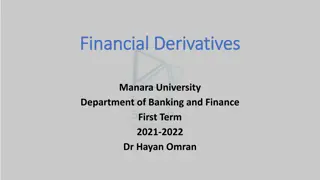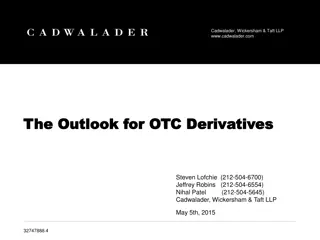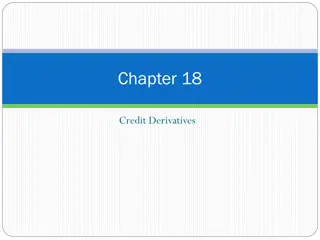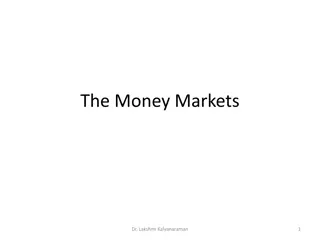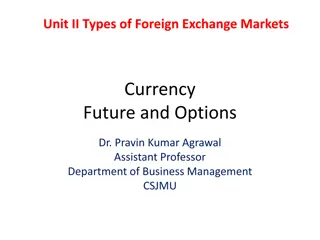Understanding Derivatives Markets and Risk Management
Explore the history of derivatives, the role of derivatives in insurance and risk management, underlying assets, derivative instruments, derivative markets, and the significant notational outstanding of OTC derivatives. Discover key players and exchanges in the derivative markets and the vast scale of options in OTC derivatives as reported by the Bank for International Settlements.
Download Presentation

Please find below an Image/Link to download the presentation.
The content on the website is provided AS IS for your information and personal use only. It may not be sold, licensed, or shared on other websites without obtaining consent from the author. Download presentation by click this link. If you encounter any issues during the download, it is possible that the publisher has removed the file from their server.
E N D
Presentation Transcript
CORPORATE FINANCIAL THEORY Lecture 11
History of Derivatives Risk Management Lloyds of London Ship building 1840s Midwest USA farmers 1848 Chicago Board of Trade (CBOT) for grain 1874 Chicago Produce Exchange for butter/eggs 1919 Chicago Mercantile Exchange (CME) Jet Fuel Land options
Derivatives Insurance Risk Management Lloyds Ship Building Jet Fuel Cost Predictability Revenue Certainty
Underlying Assets Stocks (example) Bonds Indices Commodities (examples for metal and ag.) Currencies Weather Carbon emissions Radio bandwidth
Derivative Instruments Futures Options / Warrant Future options Swaps Mortgage backed securities Forward Rate Agreement Convertible bonds Real options
Derivative Markets OTC vs. Exchanges Eurex (E-X) Chicago Board Options Exchange (CBOE) Chicago Mercantile Exchange (CME) Chicago Board of Trade (CBOT) New York Mercantile Exchange (NYMEX) Hong Kong Futures Exchange (HKFE)
Derivative Markets Notational outstanding of OTC derivatives ($ trillion) 1600 1400 1200 1000 800 600 400 Source: Bank for International Settlements https://stats.bis.org/statx/srs/tseries/OTC_DERIV/H:A:A:B:5J: A:5J:A:TO1:TO1:A:A:3:C?t=D5.1&p=20172&x=DER_RISK.3 .CL_MARKET_RISK.J:T:E:B:D:U&o=w:20121.20172,s:stc,t: Derivatives%20risk%20category 200 0
Derivative Markets Source: Bank for International Settlements Exchange Options on OTC derivatives Q2 2022 = $53,925 billion
Derivative Markets Source: Bank for International Settlements https://stats.bis.org/statx/srs/tseries/OTC_DERIV/H:A:A:B:5J:A:5J:A:TO1:TO1:A:A:3:C?t=D 5.1&p=20172&x=DER_RISK.3.CL_MARKET_RISK.J:T:E:B:D:U&o=w:20121.20172,s:stc,t: Derivatives%20risk%20category
Derivative Markets Source: WFE/IOMA Derivatives Market Survey 2021
Derivative Markets Source: WFE/IOMA Derivatives Market Survey 2021
Derivative Markets Source: WFE/IOMA Derivatives Market Survey 2021
Derivative Markets Source: WFE/IOMA Derivatives Market Survey 2018
Derivative Uses Arbitrage Speculation Hedging
Derivatives Definition Derivatives are financial instruments whose price and value derive from the value of the underlying assets or other variables (ISDA) Derivatives are a zero sum game Example: Insurance
Derivatives & Options Historical Topics (Internal to the Corp) 1 - Capital Budgeting (Investment) 2 - Capital Structure (Financing) Today We are leaving Internal Corporate Finance We are going to Wall St & Capital Markets Options - financial and corporate Options are a type of derivative
Options Long Short Call option Right to buy asset Obligation to sell asset Put option Right to sell asset Obligation to buy asset
Options Terminology Derivatives - Any financial instrument that is derived from another. (e.g.. options, warrants, futures, swaps, etc.) Option - Gives the holder the right to buy or sell a security at a specified price during a specified period of time. Call Option - The right to buy a security at a specified price within a specified time. Put Option - The right to sell a security at a specified price within a specified time. Option Premium - The price paid for the option, above the price of the underlying security. Intrinsic Value - Diff between the strike price and the stock price Time Premium - Value of option above the intrinsic value
Options Terminology Exercise Price - (Striking Price) The price at which you buy or sell the security. Expiration Date - The last date on which the option can be exercised. American Option - Can be exercised at any time prior to and including the expiration date. European Option - Can be exercised only on the expiration date. All options usually act like European options because you make more money if you sell the option before expiration (vs. exercising it). 3 vs. 70-68=2
Option Value The value of an option at expiration is a function of the stock price and the exercise price.
Option Value The value of an option at expiration is a function of the stock price and the exercise price. Example - Option values given a exercise price of $85 Stock Pric e $60 70 80 90 100 110 Call Value 0 0 0 5 15 25 Put Value 25 15 5 0 0 0
Options CBOE Success 1 - Creation of a central options market place. 2 - Creation of Clearing Corp - the guarantor of all trades. 3 - Standardized expiration dates - 3rd Friday 4 - Created a secondary market
Option Value Components of the Option Price 1 - Underlying stock price 2 - Striking or Exercise price 3 - Volatility of the stock returns (standard deviation of annual returns) 4 - Time to option expiration 5 - Time value of money (discount rate)
Option Value Black-Scholes Option Pricing Model ) = ( ) ( ) ( OC N d P N d PV EX 1 2
Black-Scholes Option Pricing Model ) = ( ) ( ) ( OC N d P N d PV EX 1 2 OC- Call Option Price P- Stock Price N(d1) - Cumulative normal density function of (d1) PV(EX) - Present Value of Strike or Exercise price N(d2) - Cumulative normal density function of (d2) r - discount rate (90 day comm paper rate or risk free rate) t - time to maturity of option (as % of year) v - volatility - annualized standard deviation of daily returns
Put - Call Parity Put Price = Call + EX - P - Carrying Cost + Div. or Put = Call + EX(e-rt) Ps - Carrying Cost + Div. Carrying cost = r x EX x t
Put - Call Parity Example ABC is selling at $41 a share. A six month May 40 Call is selling for $4.00. If a May $ .50 dividend is expected and r=10%, what is the put price? OP = OC + EX - P - Carrying Cost + Div. OP=4 + 40 - 41 - (.10x 40 x .50) + .50 OP =3 - 2 + .5 Op = $1.50
Warrants & Convertibles Review Topics (not going over in class) Warrant - a call option with a longer time to expiration. Value a warrant as an option, plus factor in dividends and dilution. Convertible - Bond with the option to exchange it for stock. Value as a regular bond + a call option. Won t require detailed valuation - general concept on valuation + new option calc and old bond calc.
Option Strategies Option Strategies are viewed via charts. How do you chart an option? Profit Stock Price Loss
Option Strategies Long Stock Bought stock @ Ps = 100 +10 P/L Ps 90 100 110 -10
Option Strategies Long Call Bought Call @ Oc = 3 S=27 Ps=30 +6 P/L Ps 36 27 30 -3
Option Strategies Short Call Sold Call @ Oc = 3 S=27 Ps=30 +3 P/L Ps 36 27 30 -6
Option Strategies Long Put = Buy Put @ Op = 2 S=15 Ps=13 +3 P/L Ps 15 10 13 -2
Option Strategies Short Put = Sell Put @ Op = 2 S=15 Ps=13 +2 P/L Ps 15 10 13 -3
Option Strategies Synthetic Stock = Short Put & Long Call @ Oc = 1.50 Op=1.50 S=27 Ps=27 +1.50 P/L Ps 30 24 27 -1.50
Option Strategies Synthetic Stock = Short Put & Long Call @ Oc = 1.50 Op=1.50 S=27 Ps=27 +1.50 P/L Ps 30 24 27 -1.50
Option Strategies Synthetic Stock = Short Put & Long Call @ Oc = 1.50 Op=1.50 S=27 Ps=27 +1.50 P/L Ps 30 24 27 -1.50
Option Strategies Why? 1 - Reduce risk - butterfly spread 2 - Gamble - reverse straddle 3 - Arbitrage - as in synthetics Arbitrage - If the price of a synthetic stock is different than the price of the actual stock, an opportunity for profit exists. Recall discussion on Real Options
Dilution + EX V Nq + = Share price after exercise N Nq 1 = Dilution factor + 1 # of new shares # of outstandin shares g
Binomial vs. Black Scholes Expanding the binomial model to allow more possible price changes 1 step 2 steps (3 outcomes) etc. etc. 4 steps (5 outcomes) (2 outcomes)
